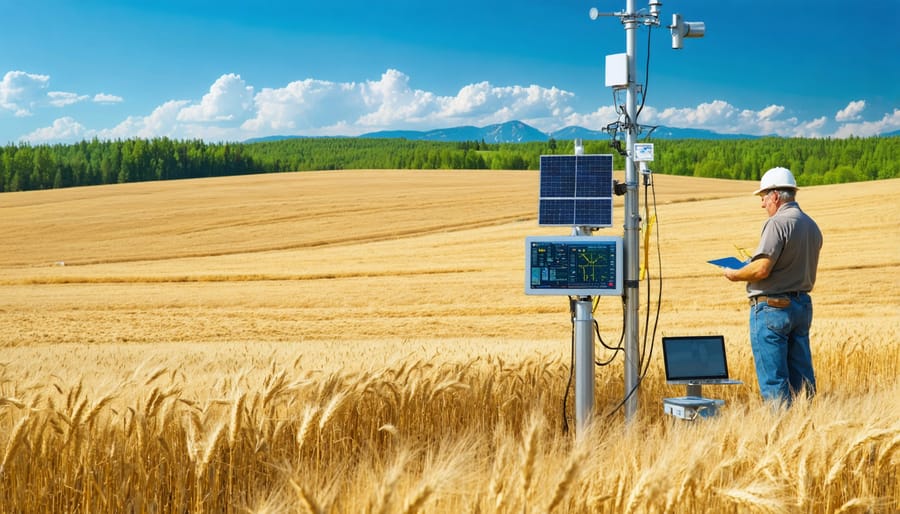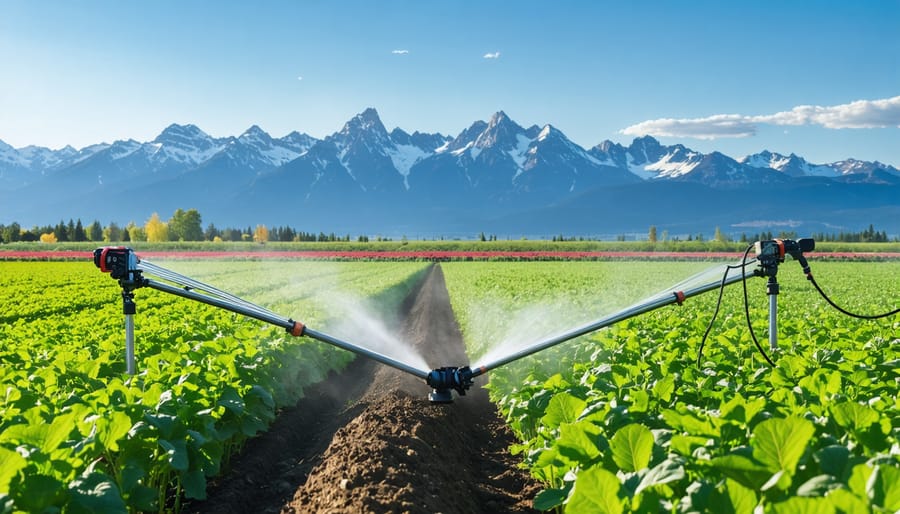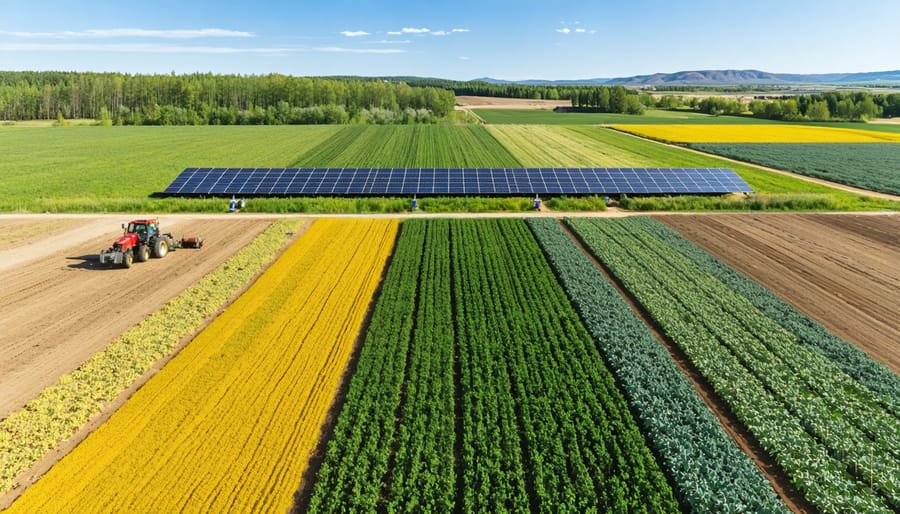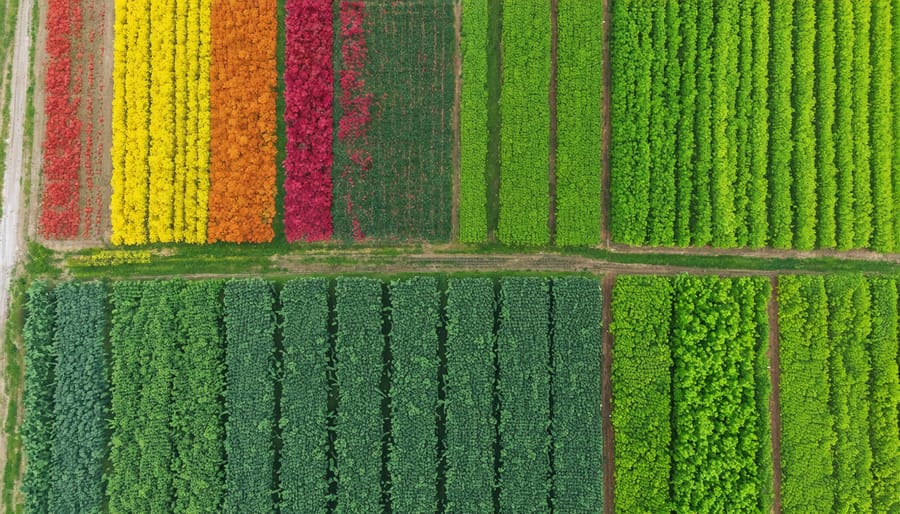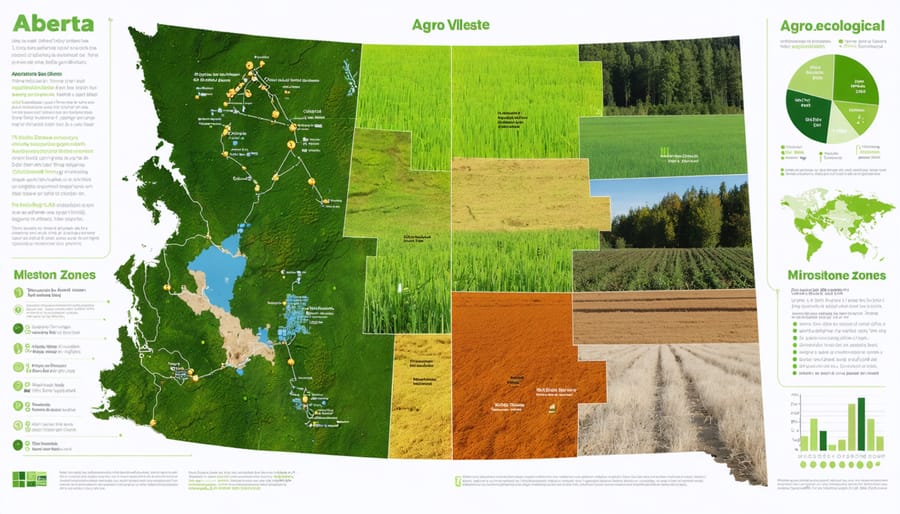Plant drought-resistant varieties like AC Strongfield durum wheat and CDC Meadow peas to maintain yields despite Alberta’s increasingly variable rainfall patterns and current agricultural challenges. Implement strip-cropping systems with 30-metre windbreaks every 100 metres to reduce soil erosion and preserve moisture, proven effective by Medicine Hat area farmers who’ve seen 20% yield improvements. Build soil organic matter to 5-7% through cover cropping and minimal tillage, creating natural resilience against both drought and flooding while reducing input costs by $50-75 per hectare. These field-tested strategies, backed by five years of Agricultural Research and Extension Council of Alberta data, help Prairie farmers maintain profitable operations while adapting to changing climate patterns. Our local success stories prove that climate-resilient agriculture isn’t just about survival – it’s about building stronger, more sustainable farm operations for generations to come.
Alberta’s New Climate Reality: What Farmers Need to Know
Key Climate Risks for Alberta Crops
Alberta’s agricultural landscape faces several significant climate-related challenges that directly impact crop production. Extended drought periods, particularly during critical growing seasons, have become more frequent across the southern prairies. In recent years, farmers have reported seeing up to 30% reduction in yields during severe dry spells.
Extreme weather events pose another major concern, with increased frequency of destructive hailstorms and intense rainfall events. The Calgary region alone experienced a 25% increase in severe hail events over the past decade. Unpredictable spring temperatures and late frosts can damage emerging crops, while heat waves during flowering periods can significantly reduce grain formation in cereals and canola.
Disease and pest pressures are also evolving with changing climate patterns. Warmer winters have led to increased survival rates of crop pests, while humid conditions promote the spread of fungal diseases. Root rot in pulse crops and fusarium head blight in wheat have become more prevalent, requiring vigilant monitoring and management.
These challenges highlight the need for adaptive farming strategies, including drought-resistant crop varieties and improved water management systems. Many Alberta farmers are already implementing innovative solutions to build resilience into their operations.
Climate-Smart Crop Varieties Taking Root in Alberta

Drought-Resistant Wheat Varieties
Several drought-resistant wheat varieties have shown promising results in Alberta’s increasingly variable climate, supporting climate-resilient grain production across the prairies. AAC Paramount, developed by Agriculture and Agri-Food Canada, has demonstrated exceptional drought tolerance while maintaining yields of 4.5-5.0 tonnes per hectare under water-stressed conditions.
The CDC Landmark VB variety, particularly popular among southern Alberta farmers, shows a 15% higher yield compared to traditional varieties during drought periods. Its deep root system, reaching up to 2 metres, helps access soil moisture even during extended dry spells.
Recent field trials in Lethbridge revealed that AC Vesper VB wheat maintained protein content above 13.5% despite receiving 40% less rainfall than average. This variety’s improved water-use efficiency makes it an excellent choice for dryland farming operations.
For organic producers, Red Fife heritage wheat has shown remarkable drought resilience. While yields may be slightly lower at 3.5-4.0 tonnes per hectare, its robust root structure and natural disease resistance make it a reliable choice during dry seasons.
These varieties perform best when integrated with proper soil management practices, including reduced tillage and crop rotation. Local seed suppliers across Alberta maintain stocks of these varieties, and many offer field demonstrations for farmers interested in transitioning to more resilient options.
Heat-Tolerant Canola Innovations
Recent developments in heat-tolerant canola breeding have brought promising solutions for Alberta farmers facing increasingly warm growing seasons. Research conducted at the University of Alberta’s crop development centre has produced several new canola varieties that can maintain oil content and yield even when temperatures exceed 30°C during flowering.
The standout variety, dubbed “HeatShield-1,” has shown remarkable resilience in field trials across Southern Alberta, maintaining up to 90% of expected yields during the heat waves of recent growing seasons. Local farmer Dave Thompson from Lethbridge County reports consistent success with this variety, noting that his 2022 crop withstood a two-week stretch of 32°C temperatures with minimal impact on seed quality.
These new varieties achieve heat tolerance through improved pollen viability and modified flowering periods. The plants produce more robust pollen that remains viable at higher temperatures, and their flowering window extends over a longer period, increasing the chances of successful pollination during cooler parts of the day.
Implementation has been straightforward for most producers, as these varieties require similar management practices to traditional canola. Seed costs are comparable to conventional varieties, making them an accessible option for farmers looking to adapt to warming conditions. Early adoption data shows a 15% increase in heat-tolerant variety usage across Alberta’s canola-growing regions since 2021.

Real Results: Alberta Farmers Share Their Success Stories
Meet Sarah Thompson from Lethbridge County, who transformed her 800-hectare farm by implementing proven climate adaptation strategies. After experiencing three consecutive years of drought, Sarah switched to drought-resistant wheat varieties and implemented precision irrigation. “Our yields have increased by 25% since making the switch, and we’re using 30% less water,” she shares.
In Red Deer County, Mark Peterson’s story offers another perspective on climate resilience. His family farm now grows AC Carribean, a heat-tolerant barley variety developed specifically for Alberta’s changing conditions. “We harvested 4.5 tonnes per hectare last season, despite the extreme heat waves,” Mark reports. “That’s a 20% improvement over our traditional varieties.”
The Johnsons, farming near Grande Prairie, demonstrate how diversification builds resilience. They introduced frost-resistant canola varieties and implemented strip-cropping techniques. “We’ve seen more consistent yields, even when spring frosts hit,” explains Lisa Johnson. “Our soil health has improved dramatically, and we’re better prepared for whatever weather comes our way.”
For Medicine Hat farmer David Chen, success came from combining traditional knowledge with modern varieties. His rotation of climate-smart crops includes drought-resistant lentils and early-maturing peas. “These new varieties give us flexibility with planting dates and help spread our risk,” David notes. “Last year, when heat stressed our wheat, the lentils performed exceptionally well, helping maintain our farm’s profitability.”
These success stories share common themes: careful variety selection, willingness to adapt, and commitment to soil health. Each farmer emphasizes the importance of starting small, monitoring results, and gradually expanding successful practices across their operations.
Making the Switch: Implementation Strategies

Planning Your Transition
Begin your transition to climate-resilient agriculture by conducting a thorough assessment of your current farming practices. First, document your existing crop varieties and their performance over the past few seasons. Next, research and identify at least three new climate-adapted varieties suitable for Alberta’s growing conditions. When implementing climate-smart farming practices, start small by dedicating 10-15% of your land to trial plots. This allows you to test new varieties while maintaining your primary production. Schedule your transitions during optimal planting windows, typically early spring for most Alberta crops. Partner with local agricultural extension services and join farmer networks to share experiences and learn from others who have successfully made the switch. Remember to maintain detailed records of your transition process, including soil conditions, weather patterns, and crop responses.
As we’ve explored, climate resilient agriculture is not just a concept but a vital path forward for Alberta farmers. By implementing strategies like drought-resistant crop varieties, improved soil management techniques, and water conservation practices, you can build a more sustainable and profitable farm operation. The success stories from fellow Alberta farmers demonstrate that these adaptations work in our unique climate conditions.
Start small by choosing one or two strategies that align with your farm’s needs. Consider joining local agricultural networks or reaching out to extension services for support. Remember, building climate resilience is a journey that strengthens with each season. Your efforts today in adopting these practices will help ensure the longevity of your farm and contribute to a more resilient agricultural community across Alberta.
Take the next step by assessing your farm’s climate vulnerabilities and developing an action plan. Together, we can build a more sustainable future for Canadian agriculture.


